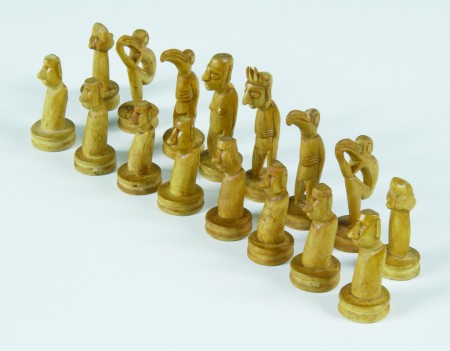Luke Drabyn ‘15
The ornate nineteenth-century Chinese cribbage board and the twentieth-century Easter Island chess set were both objects crafted for commercial purposes and sold as exotica to foreigners. As civilizations from both East and West increasingly merged as a consequence of imperialism, demand for “traditional” goods—desirable due to their foreign label—intensified, thus creating a unique system of cultural exchange.
While these goods were valued for their distinct cultural characteristics (e.g., the cribbage board was “Chinese” by virtue of its extravagantly carved designs, and the chess board “Polynesian” by virtue of its Rapa Nui pieces), one must ask: To what extent are these goods genuinely “traditional”? The game of cribbage, for instance, was invented in England in the 1600s; its origins are by no means Chinese. In the same vein, the game of chess is not Polynesian, but Persian. According to the Bowdoin College Museum of Art’s description of the cribbage board, the “craze” for such commodities “contribut[ed] to Western perceptions about traditional Chinese culture.” The same can be assumed to apply to the chessboard and Polynesian souvenirs.
As a result, the contrast between what goods are perceived as authentic (i.e., “traditional”) and which goods are in fact authentic becomes blurred. These two objects, when considered a second time within the “Domestic Lives and Play” section of The Object Show, appear as a microcosm of the products of globalization.
This larger, more encompassing idea of the spread of cultural elements does not have to be constrained to those that are tangible—the “Chinese” cribbage board, or the “Polynesian” chess set, for example. Ideas, norms, values, and other cultural elements have likewise had their impact on neighboring civilizations, and have consequently led to a unique amalgamation of not only societal goods on a global level, but the way people think about the world—and thus interact with it.
The subjects of this very course can be used as an appropriate example. As we have learned, Western and Eastern conceptions of science and medicine developed much differently, yet each has grown to incorporate some of the tenets and beliefs of the other—a modern-day example of our “Polynesian” chess set, of our “Chinese” cribbage board, but on a macro-level.
[This post is based on an assignment from Professor Leah Zuo’s Spring 2014 class Science, Technology, and Society in China. Following a tour of The Object Show, students were asked to pick two or three objects on view and devise a new “organizational scheme” that would “traverse” or “escape” from familiar scientific/technological taxonomies.]


